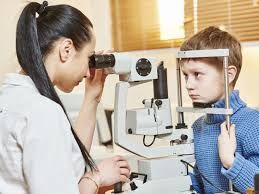Article
Knowing when to refer a young patient to an ocular genetics program
Author(s):
Pediatric ophthalmologists may need background information when treating young patients.

Reviewed by Ajoy Vincent MBBS, MS, FICO
Genetic testing is key to confirm an ocular genetics disorder and direct patients in the pediatric setting to appropriate resources, according to Ajoy Vincent, MBBS, MS, FICO, medical director of the visual electrophysiology unit at The Hospital for Sick Children and an associate professor of ophthalmology at the University of Toronto in Canada.
During his presentation at the 32nd Annual Jack Crawford Day, an annual pediatric ophthalmology update held virtually in April 2022 by the University of Toronto and The Hospital for Sick Children, Vincent discussed when the decision should be made to refer pediatric cases to an ocular genetics clinic. He underlined that a prompt diagnosis will result in appropriate management and disease prognostication.
It is important that the clinician have a high index of suspicion when seeing pediatric patients who have various visual challenges, Vincent said.
The general workflow in ocular genetics starts with initial triage of a suspected genetic disorder, with cases directed to a specific ocular genetics clinic or a subspecialty clinic such as cornea, glaucoma, anterior segment, neuro-ophthalmology, or oculoplastics, Vincent explained.
All cases typically undergo multimodal ophthalmic imaging and/or electrodiagnostic testing, he added. After this, a provisional diagnosis is reached and genetic testing is offered to the family, as well as counseling and other support services, Vincent said.
Moreover, Vincent noted that there are numerous symptoms or clinical scenarios in children that may indicate an underlying genetic condition.
When a baby exhibits poor visual behavior with or without wandering eye movement, common causes can include bilateral cataracts, cortical visual impairment, developmental eye defects, or inherited retinal dystrophy, Vincent said. Hence, clinicians need to note any details of change in visual behavior, family history of retinal dystrophy, and the child’s perinatal history to differentiate between the various causes, he added.
“All pertinent information should be included in the referral,” Vincent explained. “Some cases require urgent care whereas others may involve a slower referral pattern.”
Nystagmus that presents in a baby, as an example of a symptom that may suggest a need for immediate care, can be attributed to several factors such as bilateral media opacity, bilateral retinal disease, bilateral optic nerve abnormality, and albinism, Vincent explained, noting retinal dystrophies, metabolic disorders, and vestibular disorders also can be responsible for nystagmus.
“One thing that should be evaluated is the direction of the nystagmus, whether it is horizontal, vertical, or torsional,” Vincent said. “It should also be evaluated to determine if it is bilateral or unilateral, symmetric or asymmetric, conjugate or dysconjugate, and the age of onset.”
If a child has vertical nystagmus or torsional nystagmus that is asymmetric, dysconjugate in nature, and appears in the first 6 months of life, the nystagmus can be suggestive of a tumor, Vincent said. “This can be indicative of an optic pathway glioma, he said. “It is important to state this in the referral so that the patient can be immediately seen by the neuro-ophthalmology team at the hospital. Relevant history can help us to better help these children.”
Another presenting symptom that can include a genetic component is night blindness or nyctalopia, according to Vincent. “Commonly, this can be an indication for inherited retinal dystrophy,” he said, citing retinitis pigmentosa as an example.
One of the reasons for night blindness may be vitamin A deficiency, Vincent noted. “These days, sometimes we see children who have vitamin A deficiency because they have picky eating habits,” Vincent said. “Some of these patients have autistic spectrum disorder, which can influence eating behaviors.”
In these cases, Vincent noted it can be important for the ophthalmologist to ask about a patient’s history, family history, and any symptoms of constriction of visual field.
“Ask if the child bumps into objects or ask about any general health-related questions regarding hearing, kidney health, heart health, or digital anomalies, as this may help to diagnose complex (syndromic) disorders,” he said. “Include any relevant information in the referral.”
If a child’s visual acuity cannot be fully corrected for their age with glasses, if the fundus exam is normal, and if the child does not have amblyopia, then a retinal dystrophy is a likely diagnosis and requires a referral, Vincent said. If the fundus exam is abnormal, it could either be because of macular dystrophy or an optic neuropathy of various etiologies.
Progressive distance vision loss over a short period of time is another clinical scenario that requires a referral, Vincent noted. “You have to determine if it is sudden onset over a few days or over a period of a few months,” he said. “If it is a few days, it is likely an optic neuropathy or neuritis or acquired maculopathy. If it has been over a period of a few months, it could be the beginning of macular dystrophy or Batten disease, with the latter being a neurogenerative condition.”
Genetic testing can be useful because it can provide an accurate diagnosis and prognosis, Vincent emphasized, pointing to retinitis pigmentosa as a case in point.
“There are over 100 genes that can cause retinitis pigmentosa,” Vincent said. He pointed out that not all cases of retinitis pigmentosa have the same disease progression or disease pathway. “It can be specific for various genes, so it is very important that we do genetic testing and confirm the diagnosis. In this way, we can [give patients an] accurate or a more reasonably accurate prognosis.”
Ajoy Vincent, MBBS, MS
Vincent has no financial disclosures related to this content.
Newsletter
Don’t miss out—get Ophthalmology Times updates on the latest clinical advancements and expert interviews, straight to your inbox.




